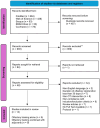The effectiveness of olfactory training for chronic olfactory disorder following COVID-19: a systematic review
- PMID: 39588055
- PMCID: PMC11586678
- DOI: 10.3389/fnhum.2024.1457527
The effectiveness of olfactory training for chronic olfactory disorder following COVID-19: a systematic review
Abstract
Background: Chronic olfactory disorders are some of the most frequent post-COVID-19 presentations. Olfactory training (OT) is currently the most popular method used for treating post-viral olfactory dysfunction (PVOD). We evaluated the effect of olfactory training on the chronic olfactory disorders of patients infected with COVID-19.
Methodology: A systematic literature search was performed per PRISMA guidelines in PubMed, Scopus, Web of Science, EBSCOhost, and the Cochrane Library. Only patients with chronic olfactory disorders of 30 days or more were included. The primary outcome was the olfactory score at the end of follow-up. In all studies, improvement was defined as a positive change over time in the results of objective psychophysical olfactory tests. The most commonly used test was the Sniffin' Sticks. Typically, outcome measures involved comparing the mean olfactory scores. In the Sniffin' Sticks test, an improvement was also indicated by a change of 5.5 points or more in the Threshold, Discrimination, and Identification scores.
Results: Fourteen studies (1.596 participants) were included in this review. Among the included studies, up to 10 were RCTs. Nine studies assessed the combined effects of adjuvant therapy and olfactory training, while five studies assessed only OT.
Conclusions: In our assessment, olfactory training alone produces significant improvements in chronic olfactory dysfunctions. However, a combined therapy approach is essential to achieve more effective outcomes. Integrating olfactory training with adjuvants like CoUltraPEALut, Cerebrolysin, and oral Vitamin A has demonstrated substantial benefits in enhancing post-COVID-19 olfactory function. Strict adherence to the OT protocol and extending the duration of OT to 3 months or more significantly enhance treatment outcomes.
Keywords: COVID-19; adjuvants; chronic olfactory disorder; olfactory training; smell.
Copyright © 2024 Treder-Rochna, Mańkowska, Kujawa and Harciarek.
Conflict of interest statement
The authors declare that the research was conducted in the absence of any commercial or financial relationships that could be construed as a potential conflict of interest.
References
-
- Boscolo-Rizzo P., Hummel T., Hopkins C., Dibattista M., Menini A., Spinato G., et al. . (2021). High prevalence of long-term olfactory, gustatory, and chemesthesis dysfunction in post-COVID-19 patients: a matched case-control study with one-year follow-up using a comprehensive psychophysical evaluation. Rhinology 59, 517–527. 10.4193/Rhin21.249 - DOI - PubMed
Publication types
LinkOut - more resources
Full Text Sources


